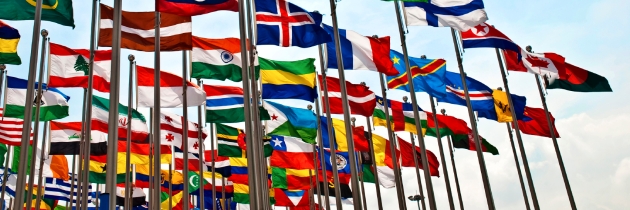Blogs

Halloween in Modern Times, A Feat from Culture to Culture
Halloween is widely thought to have originated from Celtic tradition, and was officially incorporated into the Christian calendar by Pope Gregory III in the 8th century, when he designated Novermber 1st ‘All Saints’ Day,’ and the evening before as ‘All Hallow’s Eve!’ Despite it’s unclear origins, though, and whatever it may have lost over the years from being adopted and transformed by different religions and cultures, it remains an internationally recognized event across the world. How this tradition, rooted in Celtic practice around 2,000 years ago, has managed to survive across the globe is a miracle of language. Even now, as different parts of the world choose their own distinct forms of honoring this holiday, modern global communities are scripting and learning from each other how to adapt Halloween and keep it alive for future generations! At Avantpage, we love culture, and we believe that language is the seed in which culture transmits from person to person, or nation to nation! We hope you have a great Halloween later this month, and look forward to hearing about your experiences!

Those Translation Terms!
You may have some interactions with translations companies that bring you face to face with foreign terms or processes not necessarily found in other trades! One of these terms is 'translation attestation,' which is used as a regulatory requirement to verify that the raw facts in a translated text are valid, without commenting on the quality of the translation itself! Another term you may see flung around in the U.S. translation-biz is LEP, which simply refers to a person or group of people who have 'Limited English Proficiency!' Let's turn on the heat a little here and introduce denser jargon known to the seasoned language business world.... terms like GILT. Despite how it may sound when pronounced, this has nothing to do with the feeling you may have after finishing a bag of potato chips yourself! GILT in the translation world simply stands for Globalization, Internationalization, Localization, and Translation, and is used as a broad term to refer to all the processes in global translation! If you have more curiosities about jargon translation terms, you can see our translation 411 list. As a company always striving to improve itself for its clients' benefit, we'd also love to hear you contribute your own gems of knowledge regarding difficult translation terms!

Voting Made Easy, How Translation Helps!
With information for presidential elections coming into the public sphere, as well as state and city measures and candidates, voting couldn’t be more important. It’s something we help, via translation, by making the rhetoric for measures and candidates more accessible to non-English speakers or LEPs in America! That’s why we’re proud to be a language service provider for the state of CA, making ballots as accessible as humanly possible to limited english proficiency or non-english speaking citizens! Don't forget to exercise your right to vote! Read our new case study profiling our elections translation, and discover how Avantpage completed high quality, accurate translation of over 100 Spanish language files Don’t miss our new Process Insight piece on 2012 Elections, which details step-by-step how Avantpage meets the unique challenges of translating the government documents required during an election year.

Elections: Presidential Debates 2012, A Fine Example of Rhetoric!
Last Wednesday, October 3rd, President Obama and Governor Romney of Massachusetts went at it for the 1st round of presidential debates this year. Romney made a stronger impression in polls and on social media platforms as being the candidate that “won” the debate. How people measure success in these debates seems largely to be based on the competitor’s use of rhetoric and even body language! As a translations company, we make it our business to know each and every language we work with as expertly as possible. So we ask questions like what subtleties in a speech’s delivery make it more or less appealing in the context of something like a political debate? One striking presentation on how body language affects communication conveyed that how a message is gotten across in face-to-face communication is 50% body language, 40% tone of voice, and 10% words! What do we take away from this? Being aware of how the use of language and tone can sway a speaker’s effectiveness, or even a reader’s impression of a document, helps us to be more intricate in our translation work. It shows that knowing a language and its native culture are key components to producing translations that not only preserve the information of the original document, but also the subtleties of tone and rhythm! Let us know what you think!

Translation is key in reaching Medicare beneficiaries
Help your clients take full advantage of all the services Medicare has to offer Millions of Americans are Medicare beneficiaries, yet a large percentage of these people remain unaware of all the health services they are actually entitled to receive. As part of the many health reforms implemented by the present administration, annual health checks are now offered free of charge to Medicare members. Similarly, preventive services such as cancer screenings as well as many other procedures are now being offered for free as a result of the Patient Protection and Affordable Care Act. However, few Medicare members are taking advantage of these services. Did you know that during the first two quarters of 2011, less than 20% of all Medicare beneficiaries utilized the health benefits they were entitled to? Another shocking statistic: of the 33 million Medicare beneficiaries currently listed, less than 800,000 had undergone an annual health check during the first half of the year. How to reach Medicare beneficiaries? Targeted marketing is key! Marketing campaigns geared to Medicare members will help boost awareness of available health services and benefits. Translation plays a critical role in the Medicare marketing process. When creating campaigns to reach out to Limited English Proficient (LEP) Medicare beneficiaries, it is important to ensure that information is translated accurately into your clients’ source languages. Communicating with members in their primary language or languages will improve understanding of available Medicare benefits, help them to understand and access health-related information, give them the tools they need to make better, more educated choices regarding their health care, and provide the opportunity for more positive health outcomes across the board. Accurate, high-quality translation is key to getting your message across to Medicare members who may be Limited English Proficient. Don’t let inaccuracies in translation hinder the effectiveness of your message, limit access to critical information or otherwise negatively impact your marketing efforts. At Avantpage, we specialize in translation for the healthcare industry, and handle translation duties for some of today’s most important healthcare players. For more information on all of Avantpage’s healthcare translation services, call 877-ANY-LANG or email [email protected] or get your free quote today! Also, be sure to read our case study profiling Alameda Alliance for Health, and discover how Avantpage delivered a complex project in two languages swiftly, smoothly and within budget and timeframe through the use of Translation Memory. Plus, our new Process Insight piece for Healthcare Marketing details the step-by-step process we followed to help the health plan industry communicate health care initiatives to Limited English Proficient members and potential members.

Language Spotlight: Spanish
Spanish is Avantpage’s most-requested language for translation services, but believe it or not, we have never done a language spotlight on this language before! This month, we thought we’d take a closer look at this Romance language, spoken by close to 500 million native speakers worldwide. Spanish is the official or one of the official languages of Argentina, Bolivia, Chile, Colombia, Costa Rica, Cuba, Dominican Republic, Ecuador, El Salvador, Guatemala, Honduras, Mexico, Nicaragua, Panama, Paraguay, Peru, Puerto Rico, Spain, Uruguay and Venezuela. It is the third most spoken language in the world by total number of speakers, after Mandarin and English. Spanish is also one of the six official languages of the United Nations, and is the most popular second language learned by native speakers of American English. When Christopher Columbus journeyed from the coast of Spain and landed in the Americas, his inadvertent discovery would lead to the spread of the Spanish language throughout the New World. In the following century, as Spanish conquistadors explored and conquered new territories, they brought their language with them. During the conquest of South and Central America, new forms of Spanish emerged, unique to these new regions. Today, the impact of Spain’s relentless colonization is seen in the many versions and dialects of Spanish that are spoken throughout the Americas. Modern Spanish has a variety of different dialects, and for example, the dialect spoken in Spain (known as Catalan) differs grammatically, phonologically and lexically from the Spanish spoken in Mexico, Puerto Rico, and Central America. Mexican Spanish is the most widely spoken version of this language, and is spoken by more than twenty percent of the world's Spanish speakers, approximately 107 million people. Vocabulary differs from country to country, with certain everyday words used in Spain translating into rude or obscene words in parts of Latin America and Puerto Rico. Spanish is also very closely related to the Portuguese language, but while most Portuguese speakers can understand spoken Spanish with little difficulty, Spanish speakers have a harder time understanding spoken Portuguese. Avantpage’s team of translators can translate into every Spanish dialect – from Catalan (spoken in Spain), to Mexican Spanish, to the Spanish spoken in Central and Latin America, to dialects spoken in Cuba and Puerto Rico. Avantpage has a team of expert translators in place to handle documents, media, localization requests and more. For information about our translation, click here.

Language Spotlight: Armenian
We’d like to take a closer look at the Armenian language this month, and examine its history, origins and cultural influences. We are definitely seeing more requests for Armenian-English translation, and thought Armenian would be a perfect fit for our August Language Spotlight. Present-day Armenia is a small republic nestled in the mountainous region bordered by Azerbaijan, Azerbaijan-Naxçivan, the Republic of Georgia, Iran, and Turkey. Approximately 3 million people live within the Armenian Republic, and another 3 million Armenians live in various countries of the ex-Soviet Union. One and a half million Armenians live in the Americas, one million live in Europe, and a half million live in the Middle East and Africa. Armenia’s history is tumultuous and tragic, marked by invasion, bloody wars during the Ottoman Empire, massacres at the hands of Turkish authorities during the early twentieth century, Soviet invasion and occupation, and finally, independence from Soviet rule in 1991. Armenian is spoken by 6.7 million people worldwide, and according to 2009 U.S. Census figures, there are 300,000 Americans who speak Armenian at home. Speakers live throughout the United States, Canada and Latin America, with concentrated populations in New York City, Glendale, California, Los Angeles, California and Detroit, Michigan. The Armenian language’s history dates back to a fifth century Bible translation as its oldest surviving text, and the modern language shows influences of Greek, Latin, Persian, Arabic, Turkish and other languages. The Armenian alphabet has 36 characters, allowing for a complex and sophisticated spoken and written language. Today, Armenians speak either Western Armenian, based on the speech of Istanbul Armenians, or Eastern Armenian, based on the speech of Transcaucasian Armenians, and the two dialects are mutually intelligible. Eastern Armenian is the language of the present-day Republic of Armenia. Armenia has a nearly 100% literacy rate, and education is greatly valued. Agriculture, technology, mining, textiles, and brandy production are all components of Armenia’s economic picture. Armenia has a rich tradition of musical folk dance, art, costume and tapestry, passed down through the generations. Historically, Armenian art has been associated with architecture, stone engravings, rug weaving and illuminated manuscripts. Armenian people take great pride in their history, culture, religion, arts, and cuisine. Museums, centuries-old architecture, theaters, opera, restaurants, open cafes, clubs, and of course, the natural splendor of the surrounding mountains, lakes and forests make Armenia a unique and wonderful destination for those wishing to explore an exciting country rich in historical significance and great beauty. For more information on our language capabilities, call 877-ANY-LANG or email [email protected] today!

What Is Machine Translation and Does Avantpage Use It?
Machine Translation is the process of using computer software to translate between languages. Currently, these programs can be grouped into three main categories: Does Avantpage Use Machine Translation?
There is no part of our process in which we submit text into a computer program and then get a translated document back. We use humans to translate our clients’ documents — human linguistic experts who are native speakers, understand cultural sensitivity, know industry terms, and know local dialects. Because we treat every document that we produce with the utmost care, we choose not to use machine translation tools at this time. What about Google Translate?
Google’s free Translate application is now able to handle 52 modern languages. This is extremely impressive, considering the fact that it has taken Google only a short time to do this compared to other machine translation companies. Instead of using a billion words to model the English language, Google accesses several hundred billion words. The result is a translation engine that is excellent if you need to get a fast, rough translation (such as reading a news article from another country) to simply understand the gist of a document. *** Should you have any questions at anytime about your quote, your project, or process, please feel free to ask your project manager or email us at [email protected]. We want to consistently provide you the service and product quality that meets your specific translation needs.

Case Study: Alameda Alliance for Health
Read our new case study profiling Alameda Alliance for Health, and discover how Avantpage delivered a complex project in two languages swiftly, smoothly and within budget and timeframe through the use of Translation Memory.

What Is Translation Memory and How Can My Company Build One?
Translation Memory (TM) is a database of all previous translations that were created specifically for a client. Think of a TM as a long list of A = B, where A is a sentence from the source document and B is the same sentence translated. When you submit a new document, the document is uploaded into the Avantpage online translation system and is analyzed against the TM. What this means is that all sentences that have been previously translated are automatically pulled up and inserted into the corresponding “B” field. This is called a 100% match because the new sentence matches 100% with another sentence that has been previously translated. If the new sentence matches only a portion of a previously translated sentence, it is called a Fuzzy Match. Fuzzy Matches are useful because during the translation process the translator can see how the similar sentence from a previous document was translated and base the new translation on that. This assures an added level of consistency across documents and preserves the client’s style and tone. Finally, there are the Untranslated segments, which are sentences that have never been translated before and will be translated “from scratch.”The usage of a TM increases the quality of the translated document as well as assures stylistic consistency across documents. Also, all sentences in the document are reviewed by a translator to ensure that everything is correct and accurate. *** Should you have any questions at anytime about your quote, your project, or process, please feel free to ask your project manager or email us at [email protected]. We want to consistently provide you the service and product quality that meets your specific translation needs.

New Process Insight Piece on 2012 Elections
Don’t miss our new Process Insight piece on 2012 Elections, which details step-by-step how Avantpage meets the unique challenges of translating the government documents required during an election year.

What Is a Translation Glossary? Why Is It Important to Create One?
As defined by the translation industry, glossaries are client-specific guidelines created to be used across all projects generated by a particular client. For instance, a glossary for a health care client might contain such items as: agency names, health plan names, program names, job titles and key words. All of these items need to be translated the exact same way no matter where in the document they are. It becomes even more important if we are talking about a website and the translation of navigation buttons.
To create a client glossary, our team of specialists will go through a sample set of your files and select terms that would need to be translated consistently for all your documents. They will then create a list of suggested translations, and we would submit the list for your consideration. You would then have the option to review these terms and provide us with feedback. Once the terms are finalized, the glossary is uploaded to our online translation system and the terms are automatically highlighted so that the translators are aware that there is a “rule” in place about how to translate this particular item. Although creating a glossary requires some time on the part of the linguists and the client, in the end having an approved glossary in place assures that the translations are consistent and accurately reflect client preferences. *** Should you have any questions at anytime about your quote, your project, or process, please feel free to ask your project manager or email us at [email protected]. We want to consistently provide you the service and product quality that meets your specific translation needs.